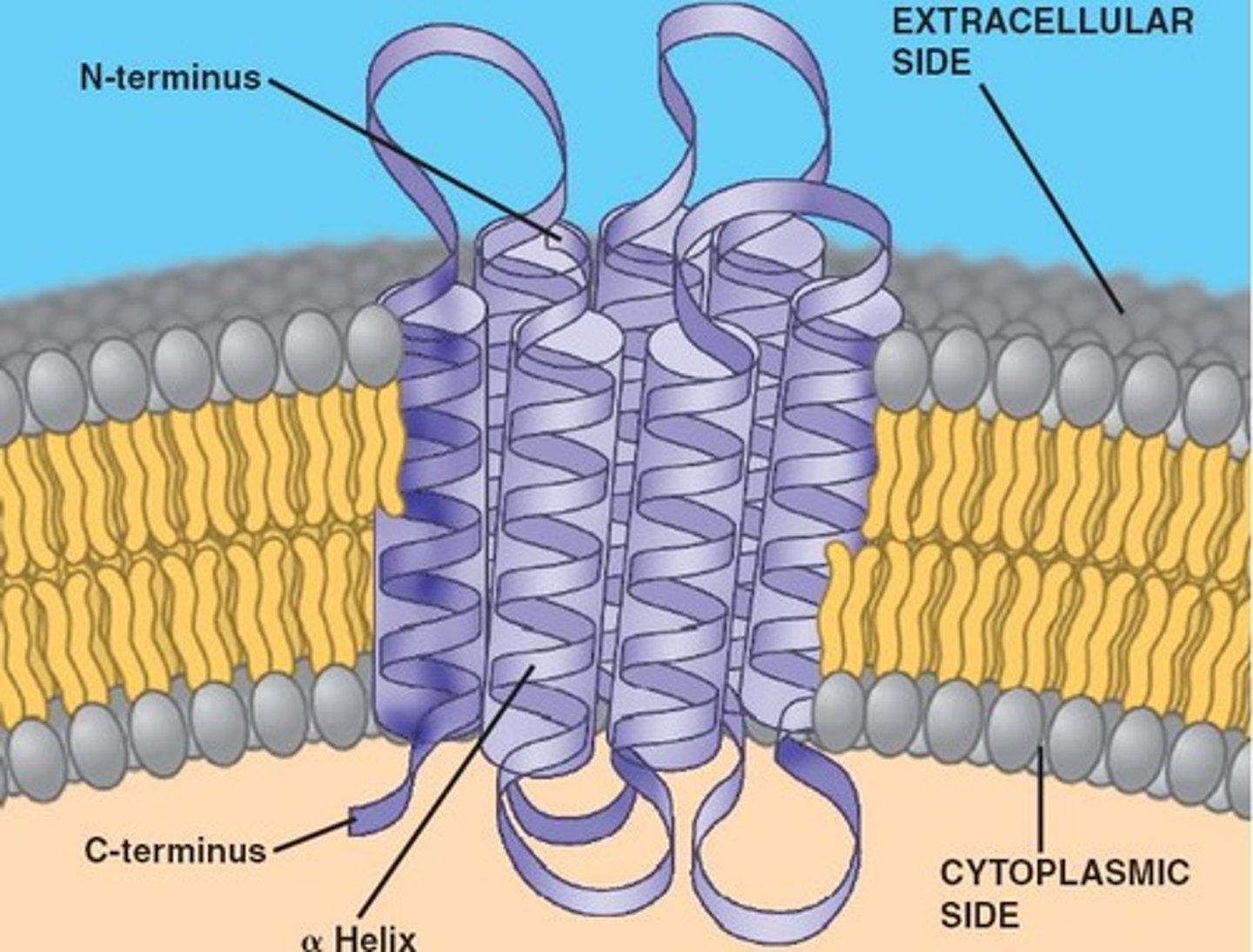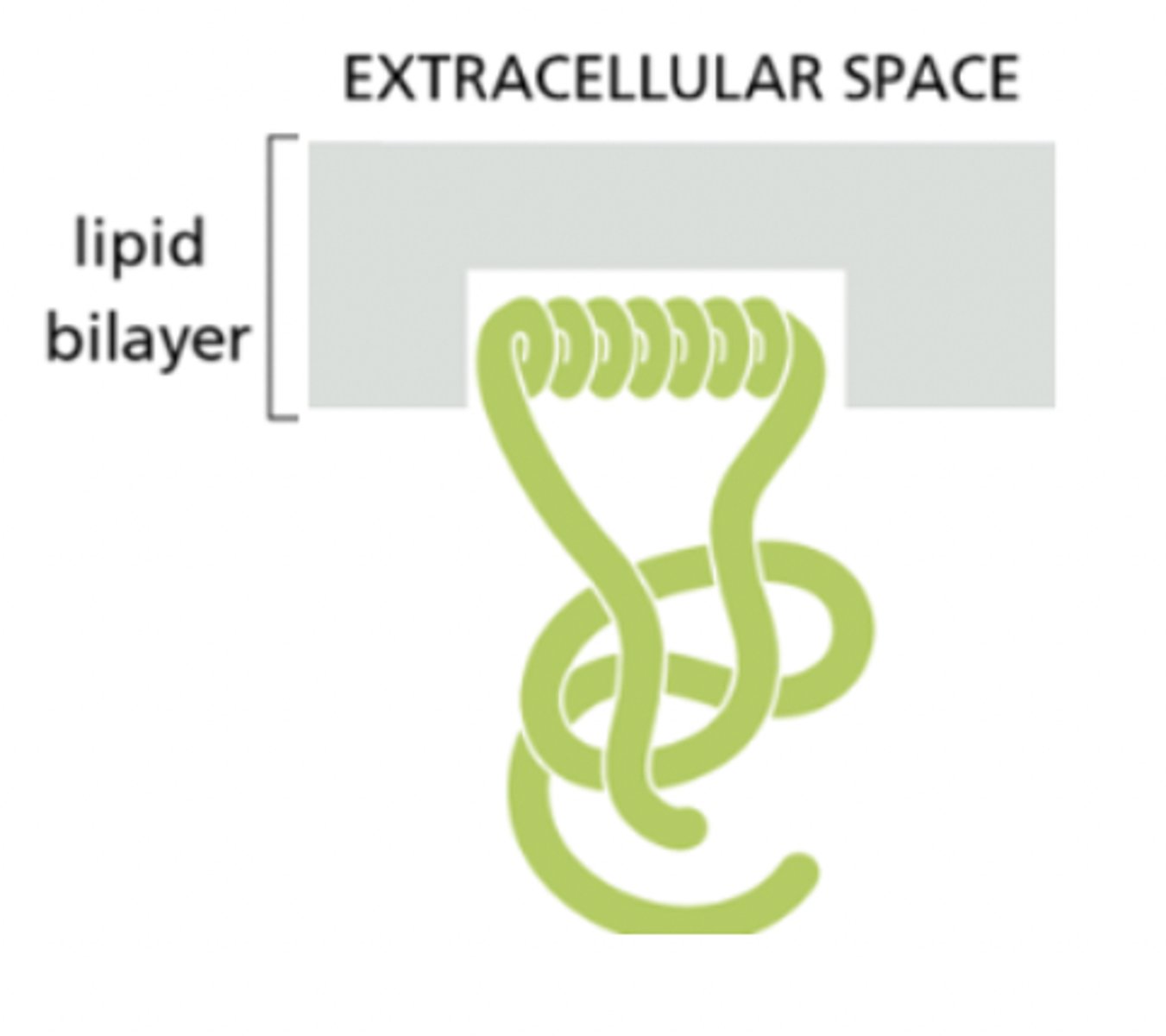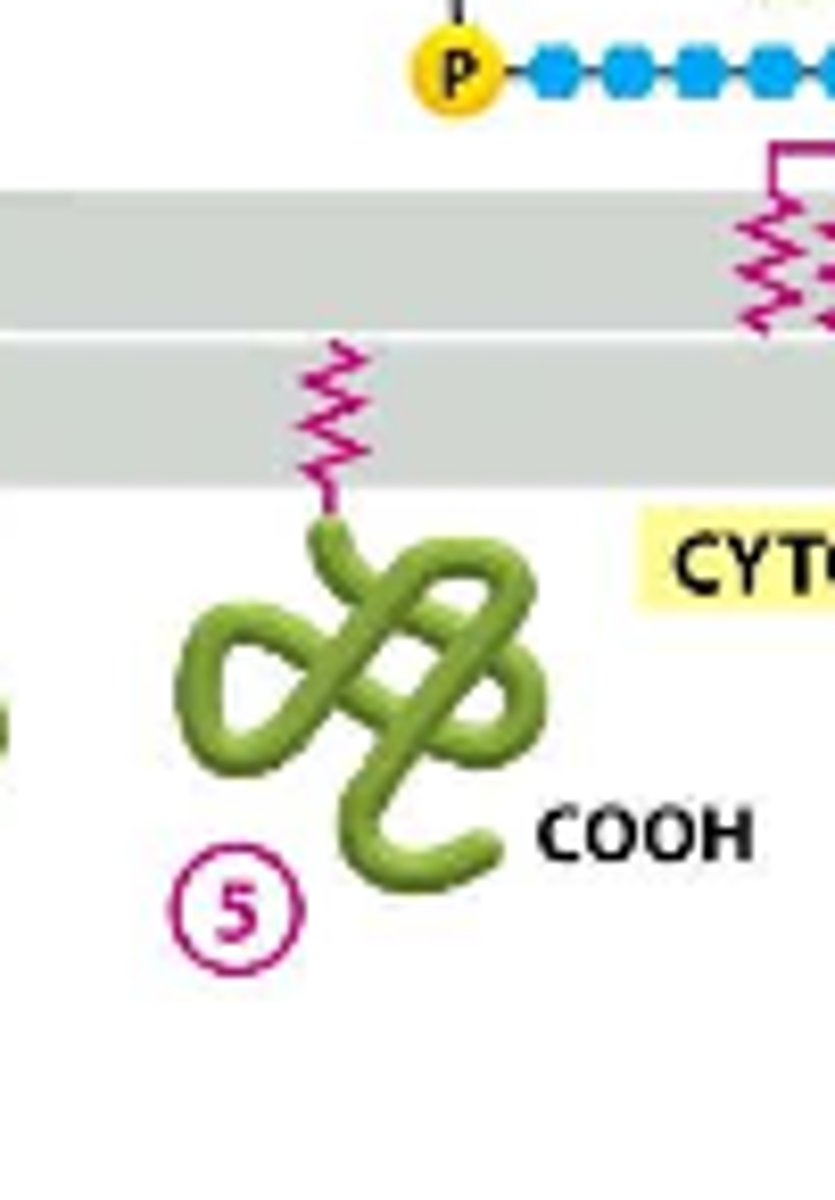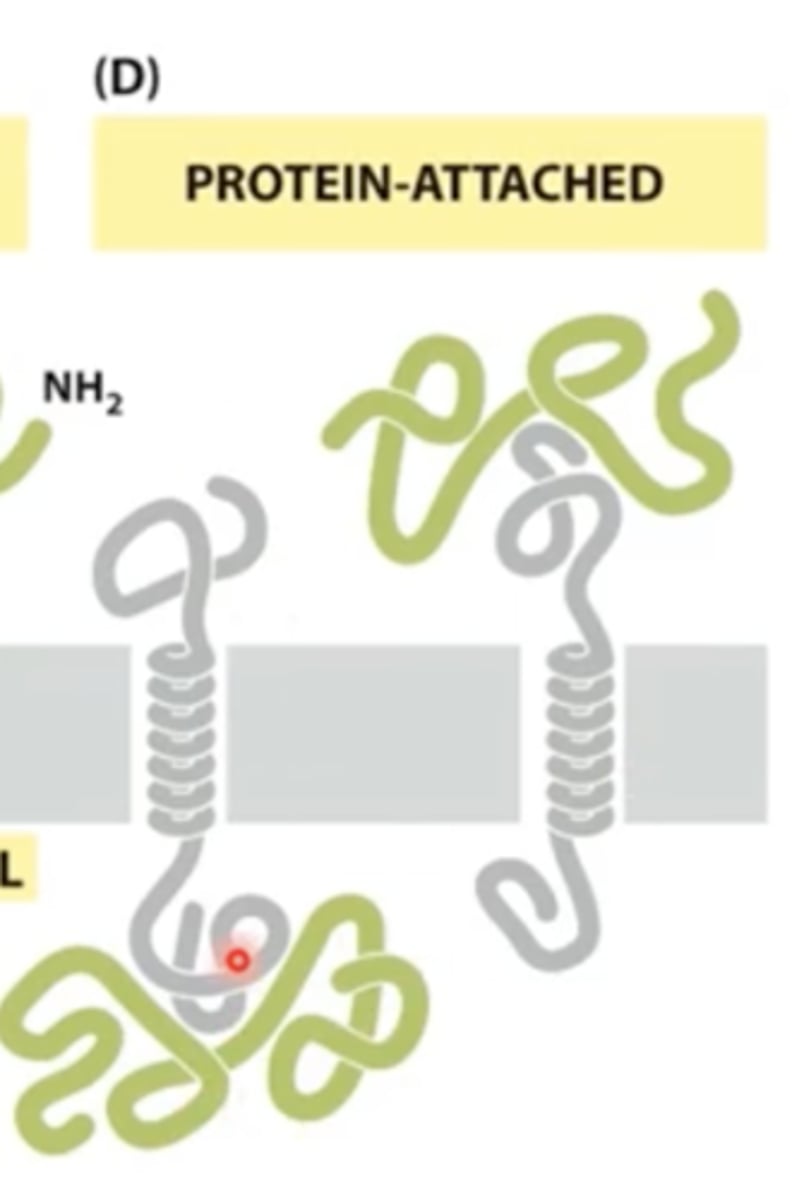Chapter 11 Lipid Bilayer
1/70
There's no tags or description
Looks like no tags are added yet.
Name | Mastery | Learn | Test | Matching | Spaced |
|---|
No study sessions yet.
71 Terms
Cell communication, import and export, growth, mobility, protection
What is the function plasma membrane
At higher temperatures cholesterol decreases fluidity and at lower temperatures it increases fluidity
How does cholesterol affect membrane fluidity at different temperatures
Endoplasmic reticulum
Where is the lipid bilayer assembled?
amphipathic
Phospholipids are ________ meaning they are both hydrophobic and hydrophilic
2 hydrophobic tails
At typical membrane phospholipid has a hydrophilic head a how many hydrophobic tails?
The lipid bilayer will spontaneously repair itself and the continuous sheet will be restored
What will happen in the plasma membrane if a small tear occurs?
The sheet may begin to fold in on itself and break up into separate closed vesicles.
What will happen in the plasma membrane if a large tear occurs?
Flip-flop
What is the least common type of movement for phospholipids within the bilayer?
Make the tails longer in hot weather and shorter in cold. More double bonds in cold weather and less in hot.
How do bacterial and yeasts cells maintain membrane fluidity during changes of temperature
Cholesterol
How do animal cells regulate membrane fluidity that is different from bacteria and yeast?
4
How many rings are in the cholesterol structure
Fills gaps created by unsaturated lipids (this makes it more rigid and less permeable)
What does cholesterol do?
20%
What weight of the plasma membrane in animal cells is cholesterol?
Protein diffusion within the bilayer, Protein/protein interactions, Cell signaling, and Membrane fusion
What 4 things does membrane fluidity impact?
Endoplasmic reticulum
New phospholipids are manufactured by enzymes bout to the ____________
No
Are the two sides of the bilayer made of all the same phospholipids?
Flippase
What enzyme causes the asymmetry between the two monolayers of the membrane?
Glycolipids are almost always in the extracellular monolayer
What monolayer are glycolipids found in?
Scramblase
What enzyme randomly flips phospholipids between the two layers of the membrane?
Enzymes in the golgi add the sugar groups to the non-cytosol side of the membrane.
Where do glycolipids get their sugars from? In other words, what adds the sugar groups to the glycolipids?
Some transport nutrients, metabolites, and ions across the membrane. Others anchor the membrane to macromolecules on either side. Some function as receptors that detect chemical signals i the cell's environment and relay them to the cell interior. Some work as enzymes to catalyze specific reactions at the membrane.
What are all the functions of proteins
Transmembrane protein

Monolayer associated protein

Lipid linked membrane protein

Protein attached proteins

Transmembrane, monolayer associated proteins, and lipid-linked proteins.
Which type of proteins are considered integral membrane proteins?
With detergent
How do you remove an integral protein from the bilary
protein-attached proteins
What proteins are considered peripheral membrane proteins
Alpha helices are by far the most common form
How do most of the polypeptide chains in the bilayer appear in the cell membrane
The polypeptide backbone is polar, and without water to hydrogen bond to this polar structure, the alpha helix is the best way for the polypeptide chain to maximize hydrogen bonding.
Why does the polypeptide chain prefer to be in an alpha helix when in the cell membrane
The hydrophobic side chains are exposed on the outside of the helix, where they contact they hydrophobic lipid tails
Describe the orientation of the hydrophobic side chains of the amino acids in a transmembrane protein
Atoms of the hydrophilic polypeptide backbone form hydrogen bonds with one another within the helix
Describe the orientation of the hydrophilic polypeptide backbone of a transmembrane protein
Single-pass transmembrane protein
Membrane protein in which the polypeptide chain crosses the lipid bilayer only once. Many of these are receptors for extracellular signals
one
How many alpha helices are required to form a single-pass transmembrane protein?
multipass transmembrane proteins
Membrane protein in which the polypeptide chain crosses the lipid bilayer more than once. These function as channels that form aqueous pores across the bilayer to allow small, water-soluble molecules to cross the membrane.
A series of alpha helices (multiple)
How many alpha helices are required to form a multipass transmembrane proteins
Amphipathic
For many multipass transmembrane proteins, one or more of the membrane-spanning regions are __________
When a beta sheet is rolled into a cylinder that forms a keglike structure.
Describe a beta barrel
The inside of the barrel
What side do the amino acids with hydrophilic side chains appear on in a beta barrel
The outside of the barrel
What side do the amino acids with hydrophobic side chains appear on in a beta barrel
Porins
____________ are an example of a beta-barrel. These form large, water-filled pores in mitochondrial and some bacterial outer membranes. The porin allows the passage of small nutrients, metabolites, and inorganic ions across their outer membranes, while preventing unwanted larger molecules from crossing.
Small, amphipathic, liplike molecules that only have a single hydrophobic tail. Shaped like cones
Describe a detergent
Micelles
In water, small conical detergent molecules tend to aggregate into small, irregularly shaped clusters called _________
These single tail molecules disrupt the bilayer and separate proteins from the lipids
What does a detergent do to a phospholipid?
SDS and Triton X
What are two examples of detergents
The hydrophobic tails of the detergents interact with the hydrophobic part of the transmembrane protein and the hydrophobic tails of the phospholipid molecules. This forms a protein-detergent complex. This complex is polar because of the hydrophilic head and can now be drawn into the aqueous environment.
How does a detergent disrupt a cell membrane and effectively separate membrane proteins
Cortex
The plasma membrane of animal cells is reinforced by the underlying _______
Plants, yeast, and prokaryotes
What organisms use a cell wall to reinforce their plasma membrane?
A fibrous layer of proteins, sugars, and other macromolecules that encases the plasma membrane
Describe the cell wall
The cortex is a meshwork of filamentous proteins that is attached to the underside of the membrane
Describe the cortex
Transmembrane proteins
What do the proteins of the cortex connect to in the plasma membrane
Spectrin (in red blood cells), Actin, and myosin
What are the most common types of proteins in the cortex?
yes
Are proteins mobile within the membrane?
Lateral diffusion
How do proteins move in a cell membrane?
FRAP (Fluorescence Recovery after Photobleaching)
How do we measure the mobility of a protein in a membrane
A protein is labeled with a GFP throughout the membrane. A laser bleaches a small section of the membrane. The bleached proteins then diffuse randomly. Eventually, the area that was bleached will appear to be fully green again because all of the bleached proteins will have diffused elsewhere. The time it takes the bleached area to turn all the way green is the rate we use to determine how fast that protein diffuses.
How does FRAP work
No
Do all proteins move at the same rate?
Membrane domain
A region in the membrane with particular proteins in an area; localized areas of proteins
membrane domains are tethered to cell cortex, extracellular matrix, and proteins on other cells.
What structures outside the cell are plasma membrane proteins tethered to outside the cell?
They restrict particular membrane components to one membrane domain.
What do membrane barriers do?
Tight Junctions
How are membrane domains maintained?
Glycoprotein
A protein that has an oligosaccharide attached to it.
Lectins
These are transmembrane proteins that are specialized to bind to particular oligosaccharide side chains.
Outside of the plasma membrane
Where is the carbohydrate of the glycoproteins, proteoglycans, and glycolipids found?
Glycocalyx
A layer of carbohydrate that helps protect the cell surface from mechanical damage. It provides a slimy coating which adds lubrication.
They have an important role in cell-cell recognition and adhesion.
What is additional role does the glycocalyx play?
proteoglycans
Protein with one or more long polysaccharide chains
The oligosaccharides are very diverse, so the lectin binds to a specific type.
What allows lectins to bind to very specific oligosaccharides?
The neutrophil cell has specific sugar groups on its membrane that are carried by glycoproteins and glycolipids. these specific sugars (oligosaccharides) bind to a specific lectin on the endothelial cells of the blood vessel. The Neutrophil adheres to the endothelial cell and crawls along the blood vessel wall. Then additional reactions allow the neutrophil to migrate across the blood vessel wall and into the infected tissue.
Describe how a neutrophil (type of white blood cell) migrates from a blood vessel to the site of infection.
The Endoplasmic reticulum
Where does scramblase work?
Golgi Apparatus
Where does Flippase work?